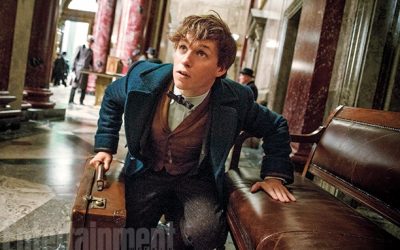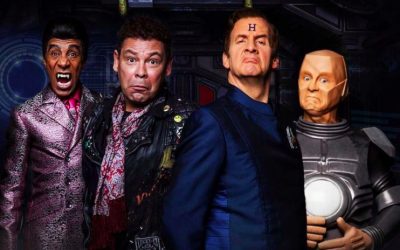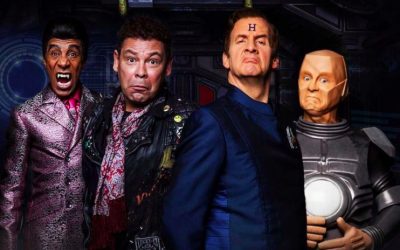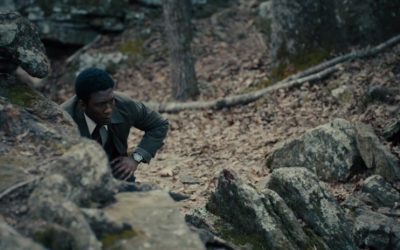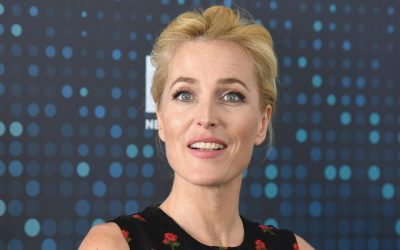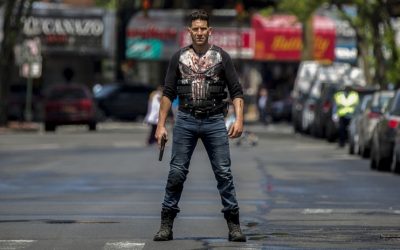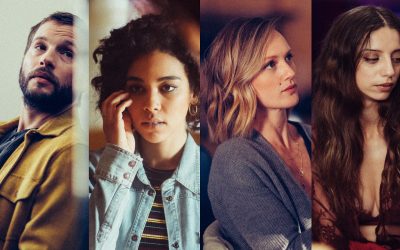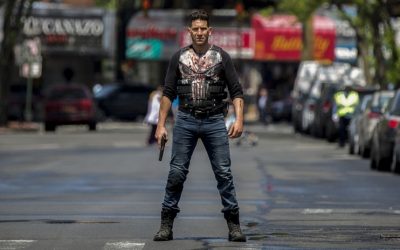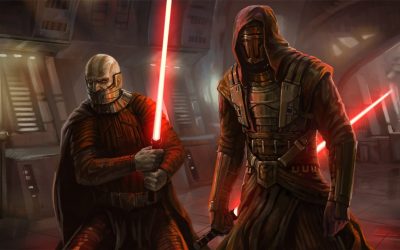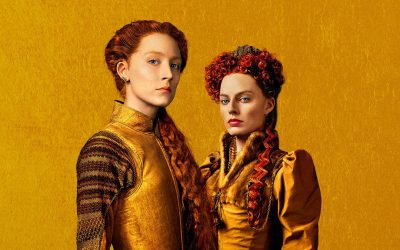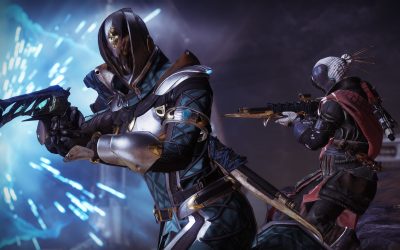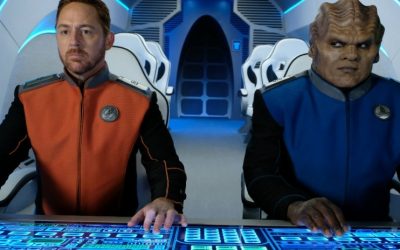
Fantastic Beasts 3 filming pushed back
Fantastic Beasts 3 isn’t ready to get going just yet…
Warner Bros. has decided to delay filming on Fantastic Beasts 3, according to a new report at Deadline. Production was due to get underway in July on the third film in the latest Wizarding World franchise, but the crew aren’t ready to get started on it after only just finishing up on the last one, which was released merely a couple of months ago.
Apparently, the actors coming back for number three have been informed of the situation in a bit of a scramble to re-jig schedules. Whether this move will affect who will be involved in the next film is currently hard to predict. Since there’s barely any info so far on which characters will be included in Fantastic Beasts 3, it’ll be open to speculation for a while.
At this time, all we know is that David Yates is coming back to direct, with David Heyman, Steve Kloves, Lionel Wigram and writer J.K. Rowling on producer duties.
We certainly doubt there’s any deeper reason for the delay in filming, as the first two films have made over $1.4 billion worldwide at the box office so far.
More on this as it becomes available.
Red Dwarf: the Dave era, Series XIII, and beyond
With more Red Dwarf on the way, Mark ponders how the sci-fi sitcom’s revival on Dave has secured its future…
For a show that’s three million and 31 years into deep space, Red Dwarf is in pretty rude health. It’s been just over a year since the programme came to the end of its 12th series, the second of a two-series production block shot in early 2016, on UK TV channel Dave, and it looks as if there’s still plenty more to come from Lister, Rimmer, Kryten and the Cat.
Having originally gone away after its eighth series aired on BBC Two in 1999, the long-running sci-fi sitcom was brought out of stasis ten years later by UK TV. While few fans would claim that the three-part special Back To Earth is Red Dwarf‘s best outing, these episodes were the most-watched original programmes in digital broadcasting history at that point, paving the way for a proper revival in 2012.
Red Dwarf X, XI, and XII represent a gradual return to form over the course of 18 back-to-basics multi-camera episodes, which largely go back to the characters for laughs. It’s a welcome approach following the continuity-heavy sci-fi escapades that characterised the last two runs of the BBC era. Co-creator Rob Grant departed the series with Red Dwarf VI, with Doug Naylor continuing on and becoming the chief creative force behind the series.
As of XII, Naylor has run just about as many series of the programme solo as he did with Grant. Over the course of the last five-and-a-bit series, the show was cancelled by the BBC, a potential movie spin-off became stranded in development hell, and the cast were all working on various other projects.
Even with all of these broadcasting and scheduling issues taken into account, Red Dwarf has found a second lease on life in the multi-channel age of television. With a 13th series and other possible projects still somewhere on the horizon for now, it’s impressive to look at what this sci-fi sitcom has achieved in the Dave era so far and what’s still to come…
Dear Dave
The Series VIII finale Only The Good ends with a cliffhanger and the simple caption “The End? The Smeg It Is”. However, having accrued a syndication-friendly package of 52 produced episodes, the BBC would then turn down Naylor’s proposals for a ninth series. Instead of another series, Naylor began to write Red Dwarf: The Movie.
Originally announced for a 2002 release, the film was set to feature the original cast, in an adventure where they’d run up against a race of ruthless cyborgs bent on wiping out the last of humanity. But as planned, the film required at least a £13 million budget and over a five-year period, the financing kept falling apart.
In the quest to get the film funded, at least one financier asked Naylor if he would consider recasting the characters with high-profile movie stars. Although there have been episodes without some of them, some of the time, a new Red Dwarf without Craig Charles, Chris Barrie, Robert Llewellyn, and Danny John-Jules would be unfathomable, and Naylor rightly “ran from the building”.
Another incident involved a would-be financier claiming to be “the Duke of Manchester”, in a not-especially elaborate hoax that would apparently have landed the production £60 million to play with, if only they’d stump up for their benefactor’s airfare to Australia. After writing 35 different drafts of the script for different potential budgets, Naylor and his team were unable to get the film funded and green-lit.
While Naylor had big ideas for the film in comparison to other British movies released at the time, this was still the era where the UK film industry was turning out anaemic, over-extended TV-to-film adaptations like Kevin & Perry Go Large and Ali G Indahouse. Red Dwarf: The Movie wouldn’t have had to do much in order to better those films, but even with the best intentions, it doesn’t feel like it would have survived contact with the film industry at that time.
All in all, Dave commissioning Back To Earth was a blessing. With a new high-definition look, improved production value, and an ambitious creative homage to Blade Runner, the specials might give us some idea of what a Red Dwarf movie might have looked like. Keeping this in mind, the de-facto “Series IX” isn’t all that great.
Aside from financial considerations, Red Dwarf is quintessentially a sitcom, so Dave commissioning further series, which once again corrected from the single-camera sci-fi format to the time-honoured multi-camera format, was the making of the revival.
In fact, in an interview for Red Dwarf X in 2012, Naylor told us: “Craig [Charles] said something interesting to me which was if we were to do the film, he wouldn’t want to leave the TV series. Because that’s where Red Dwarf really works best. Originally we were advised to do something with a really big budget whereas if we kept to a smaller budget we could have got something made.”
Additionally, having worked on so many drafts of the script, Naylor had plenty of ideas to go on. Red Dwarf X features a number of gags, scenes, and concepts that were originally conceived for one version of the movie or another, but more importantly, it’s a run that zeroes in on the original concept of the last human alive, lost in space with his misfit mates.
To cap off this victory lap, The Beginning shows a learning curve from Only The Good. Adapting much of the basic plan for the movie, it’s the standout of the run. As well as being jam-packed with great gags and character moments, it serves as a properly satisfying series finale, just in case they don’t get to do this again.
However, Dave commissioned the series for a further 12 episodes, comprising Series XI and XII. With the exception of Timewave (an uncharacteristically topical episode that definitely would have had more to grab onto if it had been written and shot at the end of 2016 rather than the beginning), they’re all pretty good ones too. By the time we get to the back-end of XII, with a blinding run of Mechocracy, M-Corp, and Skipper, the series is arguably back its very best form.
In the best way, any one of those three scripts could have been made 20 years ago, (with the possible exception of M-Corp and its Black Mirror-esque pisstake of in-app purchases) but the episodes still benefit from Naylor’s experience (plus the input of the programme’s webmaster-turned-script-editor Andrew Ellard) and the general uptick in production value afforded by TV-level visual effects.
As good as it looks, Red Dwarf still doesn’t have the budget of a Doctor Who, but the way in which the series has offset this by reviving the formula of sci-fi chamber pieces based around four spacefaring smegheads means that the show has yet more potential to be fulfilled.
Lucky XIII
We’ve been hearing for a while that Series XIII will start shooting at the beginning of 2019, but aside from the release of the new Blu-ray boxset of the first eight series, there’s been no more Red Dwarf news this year so far.
The cast have all variously confirmed that they’re raring to go on another series, but at the time of writing, the most recent word on what’s happening is Naylor’s. As far back as when Red Dwarf XII was going out on Dave, he told the Express that another series was in development.
“It would have to fit in with everyone’s schedule. Craig’s very busy and Danny’s very busy as is Chris and Rob. Danny is in Guadeloupe for half a year, so we need to get something that works for him and also we’re quite keen to do a tour.”
In keeping the original cast intact, scheduling has been an issue. However, John-Jules’ commitment in Guadeloupe, playing Officer Dwayne Myers in BBC One’s Death In Paradise, came to an end when he left the show after seven series. Moreover, Dave confirmed in April 2018 that the new series would be filming early this year, meaning that the rest of the cast must also be booked.
Going back to shooting one series, as opposed to the back-to-back production of XI and XII should mean that we get some new Red Dwarf within the next 12 months. However, post-production on the episodes shot in 2016 reportedly lasted eight-nine months, so even if doing one series halves that time, then we’re looking at the end of 2019 at the very earliest, or possibly early next year.
Wait though, what was that about a tour? In the same interview, Naylor clarified: “When I say a tour, I mean do a live show at the O2, so we need to get a schedule that works for the O2 and certainly for Red Dwarf XIII. Probably if we did a Red Dwarf XIII and XIV, it would make the O2 live show more difficult.”
He added: “So we’ll probably do Red Dwarf XIII, live show and come back and probably do XIV after that.”
It’s hard to even imagine what Red Dwarf Live At The O2 (absolutely not an official working title) would look like, but it’s the sort of mad new idea that feels on brand for the show’s digital renaissance. The mentions of two further series afterwards don’t go unnoticed either, because the Dave era has left us in absolutely no doubt that they could do it.
The End is The Beginning is The End
What’s most impressive about the post-Back To Earth series is that they haven’t relied on warm nostalgia for the show. Granted, we’ve had running jokes and callbacks galore, but they’ve largely been framed within new stories, in episodes which are markedly more characterful than conceptual. Somehow, somewhere along the line, Red Dwarf turned back into a really solid sitcom.
The audience figures for the series show that it’s still popular, and although we’ll leave the consideration of whether you could fill the O2 with the Dwarf faithful to those who have to sell the tickets, a progression to the stage feels like a more natural extension of what we’ve got at the moment than a big-budget movie could have. But moreover, it’s got a cast and crew who are raring to make the time to make more.
As we said at the start, that’s not bad going for a 31-year-old sitcom that has kept the same core cast throughout most of its run. Mathematically, we must be closer to the end of Red Dwarf than we are to the beginning. But in Red Dwarf, The End was the beginning, and having breezed past the just-in-case finale The Beginning with flying colours, it feels like there’s still lots more to come.
Red Dwarf: the Dave era, Series XIII, and beyond
With more Red Dwarf on the way, Mark ponders how the sci-fi sitcom’s revival on Dave has secured its future…
For a show that’s three million and 31 years into deep space, Red Dwarf is in pretty rude health. It’s been just over a year since the programme came to the end of its 12th series, the second of a two-series production block shot in early 2016, on UK TV channel Dave, and it looks as if there’s still plenty more to come from Lister, Rimmer, Kryten and the Cat.
Having originally gone away after its eighth series aired on BBC Two in 1999, the long-running sci-fi sitcom was brought out of stasis ten years later by UK TV. While few fans would claim that the three-part special Back To Earth is Red Dwarf‘s best outing, these episodes were the most-watched original programmes in digital broadcasting history at that point, paving the way for a proper revival in 2012.
Red Dwarf X, XI, and XII represent a gradual return to form over the course of 18 back-to-basics multi-camera episodes, which largely go back to the characters for laughs. It’s a welcome approach following the continuity-heavy sci-fi escapades that characterised the last two runs of the BBC era. Co-creator Rob Grant departed the series with Red Dwarf VI, with Doug Naylor continuing on and becoming the chief creative force behind the series.
As of XII, Naylor has run just about as many series of the programme solo as he did with Grant. Over the course of the last five-and-a-bit series, the show was cancelled by the BBC, a potential movie spin-off became stranded in development hell, and the cast were all working on various other projects.
Even with all of these broadcasting and scheduling issues taken into account, Red Dwarf has found a second lease on life in the multi-channel age of television. With a 13th series and other possible projects still somewhere on the horizon for now, it’s impressive to look at what this sci-fi sitcom has achieved in the Dave era so far and what’s still to come…
Dear Dave
The Series VIII finale Only The Good ends with a cliffhanger and the simple caption “The End? The Smeg It Is”. However, having accrued a syndication-friendly package of 52 produced episodes, the BBC would then turn down Naylor’s proposals for a ninth series. Instead of another series, Naylor began to write Red Dwarf: The Movie.
Originally announced for a 2002 release, the film was set to feature the original cast, in an adventure where they’d run up against a race of ruthless cyborgs bent on wiping out the last of humanity. But as planned, the film required at least a £13 million budget and over a five-year period, the financing kept falling apart.
In the quest to get the film funded, at least one financier asked Naylor if he would consider recasting the characters with high-profile movie stars. Although there have been episodes without some of them, some of the time, a new Red Dwarf without Craig Charles, Chris Barrie, Robert Llewellyn, and Danny John-Jules would be unfathomable, and Naylor rightly “ran from the building”.
Another incident involved a would-be financier claiming to be “the Duke of Manchester”, in a not-especially elaborate hoax that would apparently have landed the production £60 million to play with, if only they’d stump up for their benefactor’s airfare to Australia. After writing 35 different drafts of the script for different potential budgets, Naylor and his team were unable to get the film funded and green-lit.
While Naylor had big ideas for the film in comparison to other British movies released at the time, this was still the era where the UK film industry was turning out anaemic, over-extended TV-to-film adaptations like Kevin & Perry Go Large and Ali G Indahouse. Red Dwarf: The Movie wouldn’t have had to do much in order to better those films, but even with the best intentions, it doesn’t feel like it would have survived contact with the film industry at that time.
All in all, Dave commissioning Back To Earth was a blessing. With a new high-definition look, improved production value, and an ambitious creative homage to Blade Runner, the specials might give us some idea of what a Red Dwarf movie might have looked like. Keeping this in mind, the de-facto “Series IX” isn’t all that great.
Aside from financial considerations, Red Dwarf is quintessentially a sitcom, so Dave commissioning further series, which once again corrected from the single-camera sci-fi format to the time-honoured multi-camera format, was the making of the revival.
In fact, in an interview for Red Dwarf X in 2012, Naylor told us: “Craig [Charles] said something interesting to me which was if we were to do the film, he wouldn’t want to leave the TV series. Because that’s where Red Dwarf really works best. Originally we were advised to do something with a really big budget whereas if we kept to a smaller budget we could have got something made.”
Additionally, having worked on so many drafts of the script, Naylor had plenty of ideas to go on. Red Dwarf X features a number of gags, scenes, and concepts that were originally conceived for one version of the movie or another, but more importantly, it’s a run that zeroes in on the original concept of the last human alive, lost in space with his misfit mates.
To cap off this victory lap, The Beginning shows a learning curve from Only The Good. Adapting much of the basic plan for the movie, it’s the standout of the run. As well as being jam-packed with great gags and character moments, it serves as a properly satisfying series finale, just in case they don’t get to do this again.
However, Dave commissioned the series for a further 12 episodes, comprising Series XI and XII. With the exception of Timewave (an uncharacteristically topical episode that definitely would have had more to grab onto if it had been written and shot at the end of 2016 rather than the beginning), they’re all pretty good ones too. By the time we get to the back-end of XII, with a blinding run of Mechocracy, M-Corp, and Skipper, the series is arguably back its very best form.
In the best way, any one of those three scripts could have been made 20 years ago, (with the possible exception of M-Corp and its Black Mirror-esque pisstake of in-app purchases) but the episodes still benefit from Naylor’s experience (plus the input of the programme’s webmaster-turned-script-editor Andrew Ellard) and the general uptick in production value afforded by TV-level visual effects.
As good as it looks, Red Dwarf still doesn’t have the budget of a Doctor Who, but the way in which the series has offset this by reviving the formula of sci-fi chamber pieces based around four spacefaring smegheads means that the show has yet more potential to be fulfilled.
Lucky XIII
We’ve been hearing for a while that Series XIII will start shooting at the beginning of 2019, but aside from the release of the new Blu-ray boxset of the first eight series, there’s been no more Red Dwarf news this year so far.
The cast have all variously confirmed that they’re raring to go on another series, but at the time of writing, the most recent word on what’s happening is Naylor’s. As far back as when Red Dwarf XII was going out on Dave, he told the Express that another series was in development.
“It would have to fit in with everyone’s schedule. Craig’s very busy and Danny’s very busy as is Chris and Rob. Danny is in Guadeloupe for half a year, so we need to get something that works for him and also we’re quite keen to do a tour.”
In keeping the original cast intact, scheduling has been an issue. However, John-Jules’ commitment in Guadeloupe, playing Officer Dwayne Myers in BBC One’s Death In Paradise, came to an end when he left the show after seven series. Moreover, Dave confirmed in April 2018 that the new series would be filming early this year, meaning that the rest of the cast must also be booked.
Going back to shooting one series, as opposed to the back-to-back production of XI and XII should mean that we get some new Red Dwarf within the next 12 months. However, post-production on the episodes shot in 2016 reportedly lasted eight-nine months, so even if doing one series halves that time, then we’re looking at the end of 2019 at the very earliest, or possibly early next year.
Wait though, what was that about a tour? In the same interview, Naylor clarified: “When I say a tour, I mean do a live show at the O2, so we need to get a schedule that works for the O2 and certainly for Red Dwarf XIII. Probably if we did a Red Dwarf XIII and XIV, it would make the O2 live show more difficult.”
He added: “So we’ll probably do Red Dwarf XIII, live show and come back and probably do XIV after that.”
It’s hard to even imagine what Red Dwarf Live At The O2 (absolutely not an official working title) would look like, but it’s the sort of mad new idea that feels on brand for the show’s digital renaissance. The mentions of two further series afterwards don’t go unnoticed either, because the Dave era has left us in absolutely no doubt that they could do it.
The End is The Beginning is The End
What’s most impressive about the post-Back To Earth series is that they haven’t relied on warm nostalgia for the show. Granted, we’ve had running jokes and callbacks galore, but they’ve largely been framed within new stories, in episodes which are markedly more characterful than conceptual. Somehow, somewhere along the line, Red Dwarf turned back into a really solid sitcom.
The audience figures for the series show that it’s still popular, and although we’ll leave the consideration of whether you could fill the O2 with the Dwarf faithful to those who have to sell the tickets, a progression to the stage feels like a more natural extension of what we’ve got at the moment than a big-budget movie could have. But moreover, it’s got a cast and crew who are raring to make the time to make more.
As we said at the start, that’s not bad going for a 31-year-old sitcom that has kept the same core cast throughout most of its run. Mathematically, we must be closer to the end of Red Dwarf than we are to the beginning. But in Red Dwarf, The End was the beginning, and having breezed past the just-in-case finale The Beginning with flying colours, it feels like there’s still lots more to come.
True Detective season 3 episode 3 review: The Big Never
Tony Sokol
Jan 21, 2019
The horrors of the job follow Hays and West home on from The Big Never on True Detective season 3, episode 3. Spoilers…
This review contains spoilers. See related
…
The Crown season 4: Gillian Anderson to be Margaret Thatcher
Kirsten Howard
Jan 21, 2019
The Crown season 4 has chosen Gillian Anderson to portray Margaret Thatcher and lead the storyline into the 80s.
We are all fast careening towards a future in which Gillian Anderson …
The Punisher season 2: Marvel Universe Easter Eggs and reference guide
You might have to look a little harder to spot the Marvel Easter eggs in The Punisher Season 2 on Netflix, but they’re there!
This article consists of nothing but The Punisher season two spoilers.
While the Netflix arm of the Marvel Cinematic Universe has always been happy to take some liberties with their respective area of the shared continuity, The Punisher season two really seems to take that idea and run with it. Not only does it refrain from making any direct references to any major shared moments in either the main MCU or the Netflix corner of the universe (no Infinity War aftermath to be found here folks, as if that were a surprise) it also keeps a healthy distance from a good deal of its comics history.
Naturally, that doesn’t mean there are no comic book Easter Eggs and nods to be found, but this season takes its inspiration and really runs with it, plucking a handful of Punisher story deep cuts and character names and adapting them into something completely new for the live action universe. Here’s everything we managed to find on a first viewing. If you spotted anything else, let us know down in the comments, and if it checks out, we’ll update this until it’s the most comprehensive The Punisher season two resource around!
The Punisher Season 2 Episode 1: Roadhouse Blues
“While driving through Michigan, Frank stops for a beer at a roadside bar. But staying out of trouble has never been his strong suit.”
– The band at the bar is playing The Outsider by Shooter Jennings, which is a little on-the-nose for Frank’s mental state. Look, no one ever claimed The Punisher was subtle.
– Frank still goes by “Pete,” as in Peter Castiglione, a pseudonym he’s used several times over in the show that stems from his comic book history. It stems from Frank’s original Italian family name, which was later Americanised to Castle.
Our US chums have more info on the old Castiglione name right here.
– Unlike many of the other new characters in this season, Amy Bendix is actually rooted in the comics. First appearing in Punisher: War Zone #24 back in 1994, Amy’s been overhauled to fit her new role for the small screen.
Aged up and transformed into a “street-wise grifter,” Amy’s comic book counterpart was a little girl who spotted Frank escaping from one of his murder scenes, only to swear to him she’d keep his secret. Later, he even helped her recover her dollhouse. Aw.
– This episode introduces John Pilgrim, season two’s main antagonist who was developed specifically for the show. He is a Christian fundamentalist turned murderer with a strict code of ethics he is willing to kill for – but his desire to track down Amy is a major mystery.
While he’s not specifically based on any one Marvel villain, he clearly draws inspiration from Mennonite, a villain who first appeared in Punisher MAX #3 in 2010.
– Agent Madani, who you’ll hopefully remember from season one, has recovered fully from her brutal gunshot to the head, care of Billy Russo – who she obviously has not forgiven. Despite being physically in perfect health, it would seem Madani’s mental state is slipping, and badly, as she’s fixated herself like a laser on Billy and turned to alcohol to numb the pain.
– Speaking of, Billy Russo is still very much hospitalised after his final encounter with Frank last season. The weird plastic mask is thanks to Frank smashing his face through glass a few times over – and for theatricality, I guess. Art therapy, maybe.
The Punisher Season 2 Episode 2: Fight or Flight
“Frank and a reluctant Rachel go on the run as a menacing adversary gives chase. Meanwhile, Madani pays Russo an unwelcome visit.”
– Wondering what’s going on with Billy? Apparently so is Billy. He has no memory of his last encounter with Frank or anything that happened in his life after his stint in the military. If that sounds a little too convenient to you, Agent Madani thinks so, too.
– Billy’s doctor, Dr. Dumont, however, is very much on the side of her patient. Dumont isn’t based on anyone from the comics, specifically, but is definitely someone to keep an eye on as the season plays out, especially given her affinity and sympathy for Billy.
– Dumont’s advice and treatment for Billy’s memory recovery is for him to “put together the jigsaw,” an obvious nod to Billy’s comics based codename: Jigsaw. Though over in the comics Billy’s nickname was a lot more on-the-nose – he got thanks to his “jigsaw-like” facial scarring. Though the MCU’s Billy also has a pretty disgifured face, you can only make someone like Ben Barnes so ugly before you just have to give up, I guess.
Our US chums have more info on what Jigsaw was like in the Punisher comics right here.
Frank is still driving around in his, uh, “signature” van which not only featured in the first season of the show but is actually a bizarre sort of tradition for his comic book counterpart.
Dating all the way back to the debut of Frank’s “War Journal,” in Giant-Sized Spider-Man #4, Frank’s had an affinity for tooling around in clunky looking vans, sometimes they’re even known as “Battle Vans” just to make them extra on brand.
The Punisher Season 2 Episode 3: Trouble the Water
“As Pilgrim’s past comes into focus, Frank and Rachel find themselves in police custody, where they’re anywhere but safe.”
– While we still don’t have much info about John Pilgrim’s history, we get our first clue here in the form of some very old, mostly removed tattoos of Nazi and white supremacist iconography. In case you couldn’t already tell, this dude isn’t a great person.
– Netflix MCU mainstay Sergeant Brett Mahoney is back for this season! He’s been around for a while in just about every Marvel streaming show, and has a comic book history all his own, since he was introduced in Marvel Comics Presents #1 back in 2007.
– Hopefully you don’t need me reminding you of Frank’s past but he gets called a “jarhead” in this episode as a reference to his time as a Marine.
– One of the officers calls Frank out as a western hero who rides into town but is secretly the devil, which isn’t a reference to a specific western movie, but a trope used throughout the genre. Frank as the black hat, lone gunman archetype is a pretty foundational element of the Punisher character across all mediums.
The Punisher Season 2 Episode 4: Scar Tissue
“Rachel recalls the night everything changed and lets Frank in on the truth about her name. Russo sits down with a face from his childhood.”
– If you’re totally in the dark vis-a-vis Frank and Russo’s bad blood, you might want to refresh yourself on the totality of season one. This version of their story was invented for the MCU specifically, but it involves Russo being the man behind the gun that killed Frank’s family. Yikes.
– Remember Curtis Hoyle? Another major player from season one is back in this episode, and he’s Frank’s old military buddy who runs a support group for vets. It’s difficult to tell since he’s usually wearing long pants but Curtis lost his leg while he was serving and was discharged. That’s why he rarely helps Frank in actual combat.
– What is it with MCU bad guys and baseball? Billy’s history is linked to a love of baseball just like Daredevil season three antagonist Ben “Dex” Poindexter, aka Bullseye. This probably just a coincidence rather than an intentional thematic link, but still, you have to admit it’s pretty funny.
– Speaking of Billy’s tragic past, this episode is loaded with quick little refreshers and call backs to season one, like the Ray Of Hope Group Home where Billy grew up.
We start to see the first inklings of Frank actually taking Amy under his wing here, which might not be a callback to any specific comic book plot, but it’s actually not the first time Frank’s taken on a sort of ‘sidekick’ with a similar backstory.
This trajectory for Amy’s story seems to have been at least partially inspired by Rachel Cole who first appeared in The Punisher #1 back in 2011, who was motivated by the loss of her own family to join Frank’s crusade temporarily.
– You can spot MCU network powerhouse WHIH at one point in the episode, too.
The Punisher Season 2 Episode 5: One-Eyed Jacks
“It’s not a trap if you know it’s coming: That’s Frank’s philosophy. Madani opens up and Pilgrim plans to visit an unholy land.”
– Welcome back to Netflix MCU veteran Turk Barrett, who is long suffering as always. You’ll recognise him from just about every streaming Marvel show, where he’s usually getting beaten up by the good (and bad) guys for one reason or another, even after he mostly gave up his life up crime. In the comics, Turk occasionally goes by Stilt-Man (no really) and has even temporarily held an Infinity Stone, so his life is pretty wild no matter what universe he’s in.
– More season one call backs, this time to Curt’s support group for veterans, which played a pretty major role in the events of last season. It’s basically exactly what it says on the tin: a group therapy session for vets who are having trouble fitting back into daily life.
– Is it possible that Frank Castle is such a rube he doesn’t understand that three card monte is a sucker’s game? Seriously?
– Frank getting brutalised by (and in turn brutalising) a whole gym full of Russians is faintly reminiscent of the classic Garth Ennis/Steve Dillon Punisher fight with “The Russian” in their first arc on the book, “Welcome Back, Frank.” That was adapted into the very best scene in the Thomas Jane Punisher movie, with Kevin Nash as “The Russian.”
Episodes 6-9
Unless we missed something, these episodes are all Marvel reference-free!
The Punisher Season 2 Episode 10: The Dark Hearts of Men
“As Madani and Krista debate who’s worth saving, Frank prepares to storm Russo’s territory. A brutal encounter pushes Pilgrim back into old habits.”
– This episode uses a cover of Creedence Clearwater Revival’s Fortunate Son, a favorite anthem of the Vietnam era. This particular incarnation of Frank has obviously been modernised, but in his original debut back in 1974, the Punisher was a veteran of Vietnam.
The Punisher Season 2 Episode 11: The Abyss
“Amy rushes to protect Frank, who lies defenseless in a hospital. Pilgrim gets some crushing news, and Karen Page calls in a favour.”
– Hey, it’s Karen Page! Fans will recognise her from all over the Netflix MCU (not to mention Marvel comics) but specifically as one of Frank’s earliest and most trusted, er, associates, from his debut in Daredevil season two. Karen is representing Nelson and Murdock, which was newly reformed at the end of Daredevil season two with Karen as an official partner.
Episodes 12 and 13
Like six through nine, we didn’t catch any overt references to other Marvel moments in these episodes, but if you did, let us know in the comments. We have an explanation of all of the various implications of that ending right here, though.
Telling Lies: voice cast revealed for Her Story’s spiritual sequel
Telling Lies will try to build upon the brilliant Her Story with help from this cast…
Writer/designer Sam Barlow and Annapurna Interactive are teaming up to bring us a spiritual successor to the revolutionary indie game, Her Story.
Called Telling Lies, this title is described as a “spiritual successor to Her Story.” That seemingly indicates that it is not directly tied to Her Story in regards to the two games’ characters, universes, and any potential shared plot points.
However, it seems that the game will utilise a set-up similar to the one featured in Her Story. That is to say that it will require players to interpret the information given to them via live-action sequences in order to reach the end of a narrative (or at least draw conclusions regarding its meaning).
Whereas Her Story forced you to make sense of various interviews with a murder suspect in order to determine what happened, though, it seems that Telling Lies will be a little grander in scope. The plot details aren’t fully known at this time, but Barlow previously mentioned that the game would draw influences from the Steve McQueen sexual thriller Shame as well as the Francis Ford Coppola film, The Conversation. He also describes it as being “in the vein of a political thriller.”
Selling the increased scope of the game is a rather impressive cast of recently revealed actors who will portray the game’s four main characters. David will be played by Logan Marshall-Green (Upgrade, The Invitation), Ava will be played by Alexandra Shipp (X-Men: Apocalypse, Straight Outta Compton), Emma will be played by Kerry Bishé (Halt And Catch Fire, Scrubs), and Angela Sarafyan (Westworld) rounds out the main cast as Max. Vivien Lyra Blair of Bird Box also has an unidentified speaking role in the game.
We’re quite excited for this title as Her Story is not only a unique narrative experience that must be experienced by anyone who wants to see what video game storytelling is capable of, but because Barlow also worked on one of the most underrated horror games of all time, Silent Hill: Shattered Memories.
There’s no word yet regarding Telling Lies‘ release date, but the principal shooting of the live-action sequences is expected to wrap soon.
As we hear more, we’ll let you know.
The Punisher season 2 ending explained
Who lives and who dies in Frank Castle’s wake at the end of The Punisher Season 2? We explain what it all means.
In case you couldn’t guess from the title, this article contains nothing but major The Punisher season 2 spoilers. We have a spoiler free review here if you would prefer.
Chances are that this season of The Punisher is going to be the penultimate Marvel Netflix show, with only Jessica Jones Season 3 left on the slate. With that in mind, you’re probably wondering: what happens at the end of The Punisher Season 2? Where does it leave everyone? Well, read on for our explanation of The Punisher season 2 ending…
Finished Jigsaw
Perhaps the most important part of the ending is that Frank Castle, aka the Punisher, kills Billy Russo, aka Jigsaw. After everything the pair have been through, this is no small deal. As we saw in the first season, Billy Russo was Frank’s friend and brother-in-arms during his military service, though it’s fair to say that the two no longer saw eye to eye by the end of season one. It did, after all, end with Frank slicing Russo’s face up on a shattered mirror before rendering him comatose.
But despite Russo’s crimes, Frank didn’t kill him when he had the chance. Frank sparing Billy at least hinted towards redemption for a man who had previously killed almost every criminal he encountered. Sadly for fans of Frank leading a normal life, season 2 saw him backslide substantially. This time he actually finishes the job, taking out Russo so that he can’t hurt anyone else ever again.
Frank Castle at large
A large part of Season 2 involves the NYPD’s Brett Mahoney (recurring from Daredevil) attempting to capture Frank Castle and bring him to justice. A couple of times he almost succeeds. But when Mahoney is called to Russo’s body, Frank’s friends, Curtis and Madani, cover up the truth.
As such, Mahoney has no leads to follow and no case to make. He’s got nothing but his own determination to recapture The Punisher. If The Punisher Season 3 were to actually happen (which, hey, it still might…) you can believe a major part of the narrative would have been Mahoney setting up some kind of Punisher task force. As it is, you’ll just have to assume that’s the direction this is going in. After all, murdering people is against the law, even if they are criminals.
Final Page
And what of Karen Page? Well, Deborah Ann Woll makes what is almost certainly her final appearance as the character a few episodes earlier, representing Nelson & Murdock, which she helped re-form in the final episode of Daredevil Season 3 (although promises that it might be Nelson, Murdock & Page seem to have not been fulfilled, unfortunately for her).
Despite some extremely close interactions, Karen and Frank never quite get the romance some had been clamoring for – but with no more screen time for these characters likely, you can at least continue to ship it.
Born
While the first season ended with the hope that Frank Castle might never have to punish people again, season two takes the opposite approach. Frank has now fully embraced his mission, severed his ties to civilian life, and entered into a full-time war against crime as The Punisher. Where he had previously been protecting Amy, he sends her away with a bundle of money to get her life straightened out, free from any involvement with him, and gets to work.
Cut to three months later, and he’s staking out a warehouse as gangs arrive. Madani calls him from a CIA field base overseas. She’s now with the agency, and they have a target they need taken out. She trusts him to do it. She’s offering him a job.
But Frank declines, telling her he already has a job. Inside the warehouse the gangs are arguing about who set up the meeting, realizing just as we do that Frank set it up as he emerges from the darkness, in full Punisher skull vest and trench coat, then unloads two automatic rifles into the crooks ahead of him. He’s no longer going to let innocent people like his family get caught in the crossfire, even if that means giving up hope of a normal life.
This time, it isn’t personal. This is just what The Punisher does. And from now on, that’s all Frank Castle is…
Star Wars: Bioware tried to start a new KotOR project
Apparently, BioWare has attempted on multiple occasions to get a new KotOR started with EA…
Over the years, we’ve heard a lot of talk about BioWare working on a new Knights Of The Old Republic game. Their first RPG in the franchise remains an absolute classic among Star Wars fans, and both Obsidian’s sequel (The Sith Lords) and BioWare’s own MMO follow-up (The Old Republic) earned legions of fans in their respective heydays.
As for a new KotOR project from Bioware, it was reported at one point that their Austin studio was secretly hard at work on a new entry in the series. However, a recent update to the EA/Star Wars fiasco seems to indicate that isn’t the case. But, reportedly, that isn’t for lack of trying on Bioware’s part.
“They’ve tried to make it happen, more than once from what I’ve heard,” says Kotaku’s Jason Schreier on Twitter in response to a question about BioWare making another KotOR game now that EA controls the Star Wars licence. “No luck”, Schreier added, bringing our hopes crashing down once again.
On its own, there’s not much information there, but there is more to this story. First off, it’s worth remembering that Schreier has been a reliable source for years when it comes to reporting on what’s happening at various video game studios.
He’s also one of the people who previously stated that those reports which suggested BioWare is actively working on a new KotOR game are mostly false. It seems that there was a point when BioWare had pitched the idea of a new KotOR to the higher-ups at EA (and possibly worked on some kind of pitch for the game that might have included tech demos), but they never actually began work on such a project in earnest.
The question now is: “Why has EA seemingly denied them the right to do so?” That remains a mystery, of course, especially since EA’s party line is that they’re “fully committed” to the Star Wars licence. We could speculate as to why they might block Bioware from making a new KotOR entry, but it really would just be our own random theories.
What’s really heartbreaking is the implications this news has regarding BioWare’s true intentions. They’ve repeatedly stated that Anthem is the kind of game they want to make, but now we hear that they have seemingly made multiple attempts to revisit one of their most beloved franchises (beyond adding new content to the Old Republic MMO).
The shame of it all is that the second KotOR game, the one from Obsidian, left us dreaming of the possibilities of that franchise. Plus, the recent history of Star Wars games has left us fondly remembering the days in which Star Wars games were in plentiful supply. At the moment, we seem to hear of more cancelled Star Wars games than we see released ones.
We’ll keep our fingers crossed for KotOR 3 to happen at some point down the line, but it might be wise to not hold our breath…
Mary Queen Of Scots director: ‘It sticks very closely to the history’
Josie Rourke on why her new drama’s historical accuracy makes it more relevant – despite a dash of necessary fiction
It’s never easy making a historical drama for the big screen – stick too close to the history and you can end up with a stodgy story that can turn audiences off; play too fast and loose with the facts and you’ll have historians lining up to point out the flaws. For Josie Rourke, director of Mary Queen Of Scots, the answer was, well, a bit of both.
An established theatre director making her first leap to the big screen, Rourke didn’t let that particular challenge put her off. “This was a kind of go big or go home first screen adventure,” she tells Den of Geek when we catch up with her in London. “I just had this instinct about Mary that her story would benefit from a retelling.”
Based on John Guy’s biography Queen of Scots: The True Life of Mary Stuart, the film picks up in 1561, when the Scottish monarch (played by Saoirse Ronan) returns to her homeland to rule after spending most of her youth in France. Spanning a 25-year period, Rourke’s drama follows the power plays of Mary’s reign and the machinations behind her ultimate exile, culminating in her execution.
“It cleaves very closely to the history,” says Rourke. “I think it’s important to say that a lot of history is the conclusions that historians draw from primary documents. What John’s book does is it goes back to the source materials and draws some different conclusions.”
“John’s a forensic historian as well as a vivid writer and he discovered that, even within her own lifetime, Mary had been fairly comprehensively maligned and ‘fake newsed’,” she continues. “What he unearthed was a lot of hiding, destroying or overwriting of the archives about Mary’s life, which either branded her as a tragic figure who was too emotional to be a competent politician, or basically ‘slut-shamed’ her.
“I just wanted to get rid of that, like John’s book did – to go back to the primary documents around Mary’s history and identity and try and tell a more truthful story.”
A meeting of minds
But what’s really interesting about the film is how it portrays Mary’s relationship with her English cousin, Queen Elizabeth I (Margot Robbie) – a fierce yet respectful, almost sisterly rivalry that played out over a series of fascinating letters. While the film largely sticks to a voiceover-led back-and-forth, it does imagine one key scene where the two queens meet.
As you might have guessed, it’s this scene that has really got staunch fact-checkers’ tails in a spin. It’s also one of the film’s standout sequences, giving Ronan and Robbie a platform to really show off their acting A-game.
“They emphatically never met,” confirms Rourke. “That meeting is based on a gigantic correspondence. Doing it all by letter would make for an incredibly dry film, so that’s an act of imagination based on that correspondence.
“But the other thing is that we are not the first people to do that, as much as I would like to claim that we are,” she says, referring to the plethora of plays, operas, movies and TV shows that have portrayed a similarly made-up meeting between Mary and Elizabeth. “It sits in a tradition of great roles for women.”
Luckily, Rourke says, her two stars were more than up for the challenge. “Saoirse and Margot really inhabit their roles and that’s exciting to me. They are incredibly intelligent woman but they’re also very physical creatures, and they complement each other’s energy. Mary and Elizabeth are two sides of the same coin. There’s a magnetic thing going on – they attract and repel. That’s always a powerful energy if you can get that right on screen – and I think they have it.”
Sign of the times
Another criticism often aimed at big-screen historical dramas is that they filter past events through a modern lens, using them as a device to channel social commentary. As Rourke says, though, that’s not always the case – in fact, there are aspects of historical society that match our own more closely than we think.
Case in point? Mary’s friend and confidant, David Rizzio (Ismael Cruz Córdova), and her second husband, Lord Darnley (Jack Lowden) – two well-known figures from Scottish history. Rizzio was accused of being Mary’s secret lover, and became a pawn in the plot to oust Mary from the throne. What hasn’t been explored before though, on the big screen at least, is a more complicated relationship between the three…
“What’s been interesting about the response to the film in some quarters is the idea that we have tacked on that Rizzio was homosexual and that Darnley was bisexual,” says Rourke. “But we know that. Darnley’s nickname in the Scottish court was the ‘great cock chick’. It was an incredibly queer period in that sense, and I feel like some people have sort of responded to that as if it’s a 21st-century imposition.
“Actually, I think we have largely forgotten how queer the 16th century was. And that’s partly because it’s not taught – we sweep it under our big educational carpet. So that actually is about really reigniting some of the things that we’ve always known to be the case.”
Likewise, while the film might be especially relevant to today’s societal climate in terms of its feminist angle, Rourke points out that the challenges faced by the two queens in their respective, male-dominated courts certainly haven’t been overly dramatised.
“They faced gigantic odds, not only in improving their legitimacy to be the ruler of their countries, but also their legitimacy to hold that place as a woman,” she says. “It’s certainly the case that this was a period of history where many people thought it was against nature for women to lead… I’m not sure that’s totally bled out of our culture just yet.”
Mary Queen Of Scots is in cinemas now
Destiny 2: the “vast majority” of Bungie is still working on the game
Bungie remains committed to Destiny moving forward, following the split from Activision
In case there was any doubt, Bungie wants you to know that developing Destiny 2 is the company’s top priority moving forward.
“Long-term, Bungie is committed to Destiny,” says Destiny director Luke Smith via a letter posted on the Bungie website. “We created the universe and we hold its future entirely in our hands. The vast majority of the team is hard at work envisioning future experiences, enemies, and ways to play the Guardian you’ve been building since 2014. We’re going to keep doing that…we’re thinking about what it means to be truly independent, what it means to self-publish, and crucially, what Destiny‘s future can now look like for our players.”
That last line might read as a shot at Activision, but that doesn’t seem to be the case. Smith takes the time to thank Activision just as others at Bungie have in the past. Granted, that’s most likely a piece of PR obligation, but it doesn’t seem that Bungie is placing all of Destiny‘s problems at the feet of Activision.
Instead, the letter reads more like an admission of sorts in which Bungie confesses that they’re not entirely sure where Destiny goes from here, but that the majority of their team is committed to answering that question. There’s a welcome bit of honesty hidden in the letter, with Bungie admitting that they have to figure out what Destiny looks like now that they are independent seemingly doubles as confirmation that they didn’t leave Activision with a firm plan in place regarding what they intend to do with the game.
That might sound like a bad thing, but it does shed a little light on the split from Activision. It really does feel like Bungie’s general feeling was that they were being constrained by Activision’s requirements and felt the need to break free in order to have the chance to discover what Destiny can be.
Certainly, those fans who still believe in Bungie and the Destiny concept may see that as the best thing to happen to the game. Whether or not that proves to be the case remains to be seen.
The Orville season 2 episode 4 review: Nothing Left On Earth Excepting Fishes
Ryan Britt
Jan 21, 2019
If there is a Star Trek: Discovery vs. The Orville feud, this episode will probably make it worse. Spoilers ahead in our review…
This review contains spoilers for the episode, and for…

